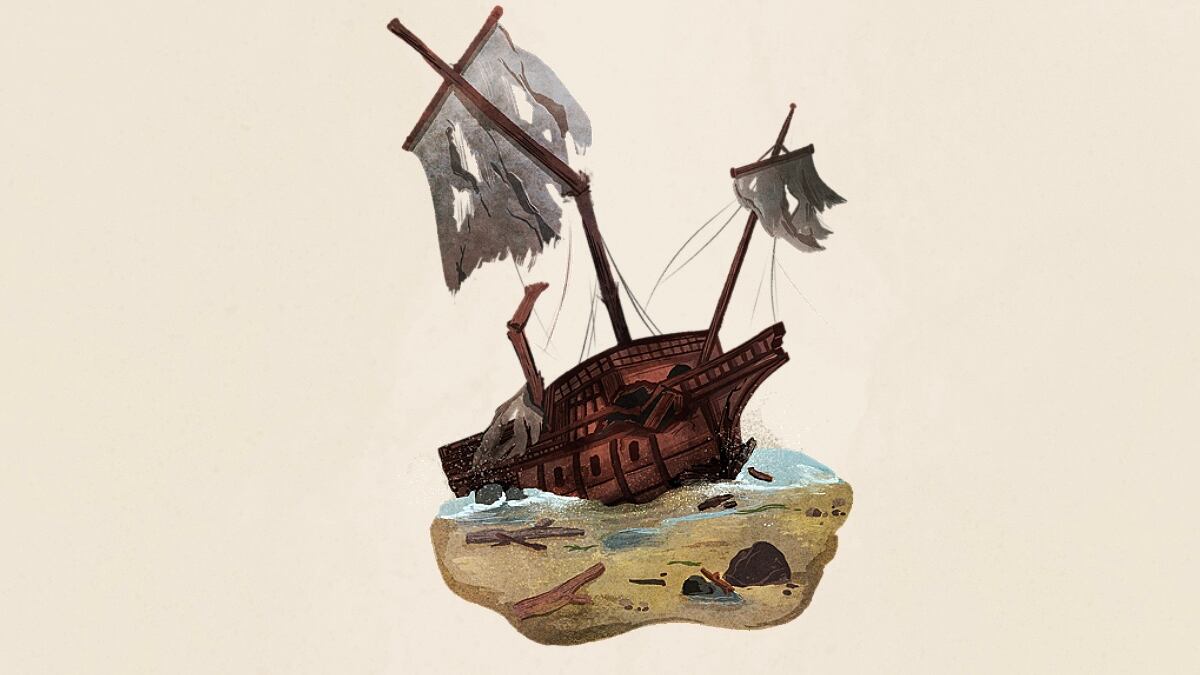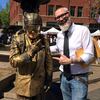For more than 300 years, chunks of beeswax, formed from Filipino pollen, and shards of Chinese porcelain have washed up on the North Oregon Coast around Nehalem—flotsam of a wrecked ship.
Beachcombers have been turning up the artifacts for decades, and larger hunks of the beeswax can be found on display at little coastal museums and libraries. Fantastic fables of treasure have been folded into the story. From the time of Astoria’s founding in 1811, white settlers have heard Native legends of a distressed ship, and then searched for hordes of silver, gold and jewels secreted away on Neahkahnie mountain—the bountiful beeswax detritus providing presumed evidence of these aged claims.
It is an Oregon legend older than the political construct of “Oregon” itself. Even if you haven’t heard the tale, you’ve seen it referenced: The Beeswax Wreck is the source material that inspired One-Eyed Willy’s treasure ship in The Goonies.
For the past 16 years, Scott Williams has been searching for that galleon. Two months ago, his team recovered timbers that provided long-awaited proof of what ship met its doom in the Pacific.
Well, maybe, Williams concedes.
He captains a group of dedicated volunteers, called the Maritime Archaeology Society, that since 2006 has tried to solve the mystery of the ship’s identity. After combing countless historical records, examining the thousands of pieces of physical evidence found along the shore, and consulting with other experts around the globe, the team formed a hypothesis. Their theory: The specific ship that wrecked along this stretch of the Oregon Coast was the 17th century Spanish galleon Santo Cristo de Burgos.
In 2013, commercial fisherman Craig Andes discovered a cave with water-logged timbers, partially buried in sand, that he believed was some of the wreckage from that ship. In 2020, he contacted the society and informed it of his cache.
The cave is located on a particularly treacherous section of rugged coast, north of Manzanita, at a site accessible only at extremely low tides. Permits from multiple agencies were obtained to retrieve the artifacts, and in mid-June (as originally detailed by National Geographic and The Daily Astorian), a dangerous, lightning-fast recovery operation, two years in the making, removed the centuries-old ship timbers.
Last week, WW met with Scott Williams, an archaeologist with the Washington State Department of Transportation and president of the Maritime Archaeology Society, in Olympia, Wash., to discuss this Oregon history legend. He told us about their recent discovery, and the 300-plus-year-old ship’s timbers that support their theory. (Maybe.)
WW: How big of a part of your life has this ship become?
Scott Williams: From the beginning, for me the search has been an interesting puzzle to be solved: When we started, no one was sure what kind of ship the Beeswax Wreck was, or where it came from or why it was on the Oregon Coast. I didn’t grow up with the story and, in fact, had never heard about it until my friend called and asked me to work on the project, and I didn’t know anything about the Manila galleon trade. That let me approach the puzzle without any preconceived ideas or biases—I didn’t have a dog in the fight about whether it was a Spanish galleon, a Chinese junk, or some other ship, or whether it was the galleon of 1705 or a different one.
There’s been a lot of people involved over the 16 years. And really, it’s just people who were interested in, wow, this Spanish galleon wrecked on the Oregon Coast! When, where, how, why kind of thing.
Have you solved the mystery?
We are 99% certain we know the ship that wrecked. We know when it wrecked, but we just don’t know where exactly it wrecked.
We certainly don’t know why it wrecked. It should not have been here in Oregon. So our goal is to keep kind of investigating that end of it. We would love to find the offshore wreck that we could do some limited excavations in and find a Spanish anchor or a Spanish cannon where we could say we’re now no longer 99% certain, we’re 100% certain.
You have selected the galleon Santo Cristo de Burgos, a Spanish galleon, as the probable ship. Why?
In the 1500s, the New World’s getting discovered, it’s the European age of exploration. European powers create this huge trade with Africa, India and China. And from China, they start getting luxury goods: silk, cotton, spices. Those are the big three, and porcelain.
The Spanish have a colony in the Philippines, its main purpose is to buy Chinese goods. They start exploring this trade, and because of the trade winds, the monsoons and all that, really, it’s only practical to sail about once a year. You leave the Philippines in June and ideally reach Acapulco, Mexico, by Christmas. Then you sell everything. You refit the ship, the ship sails from Acapulco in March, and it makes it back to the Philippines in three to four months. Back to the Philippines in time to load a whole new cargo and then set sail again.
The trade eventually evolves to essentially one big ship every year. It leaves Manila in June, sometimes July. For 250 years, that trade goes on. The ships get bigger and bigger because if you can only send one ship a year and that’s your entire economy, you have to send a big ship. So they are maximized, super-cargo carriers. Massive, slow ships. Big crews, 200 to 300 crew members.
Because that trade was so important, it was controlled by the Spanish government. Every ship was tracked, they had a cargo manifest, they knew the crew. If a ship went missing, they went looking for it because they wanted to find the cargo.
So, in that 250-year period, you only have four sailing ships from Manila to Acapulco that just disappeared. One of them is in Baja, Mexico. One of the other three is the wreck we are examining.
It shouldn’t be in Oregon. There was no reason for that ship to be here. They weren’t up here exploring or making a new settlement. They weren’t looking for food or water. They’re either way lost or disabled.
How far north would it have been reasonable to expect a ship under Spanish control to come?
About Monterey Bay. Maybe a little farther north, but not much farther. San Francisco, tops. So, to be up here, it’s way off course.
In 2018, you co-wrote an article for Oregon Historical Quarterly that detailed the conclusions you came to supporting your theory that the beeswax ship was the Santo Cristo de Burgos. What was your evidence?
We worked with Curt Peterson, a coastal geologist who specializes in the ancient earthquakes and their effects on the coast. Curt came out and he did his mapping with ground-penetrating radar and said the only way your artifacts could get to where they are is the 1700 tsunami. So that was our first clue.
Then we started working with the Spanish archives, and there’s a 1699 letter from the governor of Mexico to the king of Spain, six years after the Santo Cristo de Burgos Manila departure, informing the king that despite six years of searching the islands of the west Pacific and the coasts of New Spain, the ship vanished without a trace.
Finally, historians’ accounts: In 1917, one wrote about the galleon trade, and an extensive history of the Philippines in 1909 also stated that the ship set sail in 1693 and was never seen again.
So the discovery of the timbers really is just another piece of supporting evidence in your hypothesis.
Correct. We knew about the ship timbers since 2020. We turned in a report to the state of Oregon in January of 2021, with a proposal that we need to go collect these timbers before they wash away, or before souvenir hunters took them away.
And honestly, I’m not 100% sure that these timbers are from the Santo Cristo de Burgos. I spent Friday in Astoria, and I collected samples of wood from these beams that we’re going to mail out to the Philippines and to a radiocarbon dating lab to get more dates and better wood ID. Because it’s possible that this is a different ship. It is a shipwreck, but it’s possible that it could be a Japanese junk. As we know from the Indian histories, another ship wrecked about 1770.
The simplest explanation is, it’s our Santo Cristo de Burgos. It’s right where it should be. It’s definitely shipwrecked pieces, but it is possible that it’s not the wreck.
How much physical material did you recover in the cave?
We’re still analyzing it. We recovered some pieces that once we got back and kind of cleaned them up clearly aren’t [from] the ship. But we have more than 20 pieces we think are from the ship.
Some pieces measuring a foot in length, very water worn, to 7½ feet. Most of the pieces are under 3 feet. I want to say five or so that are more than 3 feet long. Some have more distinctive features, and we’re hoping we can send pictures and 3D models of those pieces to the people who really know Spanish ships and say, “Does this look like a rib from a 17th century galleon? Does this look like it’s from the upper deck?”
So the Santo Cristo de Burgos was transporting porcelain and beeswax. How much beeswax?
We don’t know for sure. These ships carried anywhere from call it 40 tons of beeswax up to like 100 tons of beeswax. We don’t know how many tons of beeswax was carried on the Santo Cristo de Burgos, but beeswax was actually a small part of the cargo. So if you stop and think how much beeswax has been found over the past 300 years, that was the small cargo on the galleon. The big cargo was silk. And cotton, which of course is all deteriorated, unless we find some buried in the mud. Spices and Asian luxury art, Japanese lacquerware…
And a metric shit-ton of treasure!
There was probably some gold jewelry.
I’m talking gold and silver, I’m talking Goonies shit, tons of Goonies kind of treasure.
No, no, it wouldn’t have been tons of it. Probably some gold jewelry, but not like the galleons in Mexico or Columbia. The art and the silk were the real valuable items.
The rich passengers, they had their family fortunes. But we’re not talking galleons in Florida where there was 50 tons of gold bullion, or a hundred tons of gold or silver bullion. There could have been, you know, a Catholic priest who had 200 pounds of gold. Maybe, if he was a really corrupt priest, 500 pounds of gold, but not 5 tons of gold.
Well, that’s disappointing!
Sorry.
So what questions do you still have?
Now that we know what ship was wrecked, what really interests me is the effect the tsunami of 1700 had on the wreckage: Is part of the ship still offshore, or is it all on land? If the tsunami picked it up and deposited it on land, what is the offshore source of the porcelain and wood that continues to wash ashore?
This is just another piece of supporting evidence. This isn’t a, oh my goodness, we discovered blank. This is, you know, we are on the right track.

